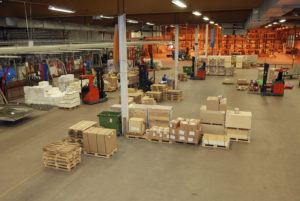Warehouses, served by increasingly powerful automated materials-handling equipment, are steadily getting taller, posing new fire risks and stressing traditional fire protection systems like heat-triggered ceiling sprinklers.
FM Global, a global commercial property insurer, has pioneered research on next-generation sprinklers that, if brought to market, are designed to activate earlier and in batches, better suppressing highly challenging fires. A new FM Global report (www.fmglobal.com/researchreports) provides an early glimpse into their reliability and cost-effectiveness. It complements information from actual fire testing already documented in two previously issued reports.
As conceived, new “SMART sprinklers” (SMART stands for simultaneous monitoring, assessment and response technology) will use multiple sensors and programmable logic to extinguish fires more quickly with less water, theoretically enabling warehouses to be bigger, use less-expensive water systems and store more challenging materials.

“In order to provide their benefits, SMART sprinkler systems are more complex,” said FM Global Vice President of Research Louis A. Gritzo, Ph.D. “That’s why we have performed research on their reliability and costs as well as their benefits. These variables are important to our clients in designing resilient storage solutions.”
The research envisioned highly challenging fire risk conditions, meaning those outside the scope of existing FM Global protection recommendations. An example is a warehouse storing paper rolls in stacks taller than 42 feet (12.8 meters) protected by SMART sprinklers. The study compared this scenario to conventional risk conditions—a warehouse storing standard materials at a height below 42 feet and employing traditional sprinklers.
The new report, called “Evaluation of the Availability of the SMART Sprinkler System,” found that:
- Estimates of the availability of these early wired and wireless SMART sprinkler configurations (i.e., their ability to operate when called upon) is 86 percent and 83 percent, respectively, over a 30-year product lifetime—compared to 97 percent for an established, traditional sprinkler system.
- The gap between SMART sprinkler availability and that of traditional sprinklers can be roughly halved by increasing inspection, testing and maintenance from once to twice yearly.
- The estimated lifetime cost of inspection, testing and maintenance of traditional sprinklers is 50 percent lower than that of SMART sprinklers.
In a sample case used to provide a preliminary evaluation of the technology, initial installation cost for a 55,000-square-foot (5,110-square-meter) warehouse was estimated to be US$280,000 for traditional sprinklers, US$710,000 for wired SMART sprinklers and US$740,000 for wireless SMART sprinklers. Actual cost would vary widely depending on the setting, vendors and configuration.
“Like all technology, fire protection solutions are evolving in exciting new ways and will continue to evolve,” said Gritzo. “Our role is to provide innovative solutions to the marketplace, inform clients about their options, guide them so they can make good decisions and help prevent losses that could harm their business.”
The SMART sprinkler used in the research was a proof-of-concept design created by FM Global researchers, not a commercially available product. Therefore, the availability and cost-benefit values are intended only as initial guidance for companies considering placing such a product on the market and for clients for whom the product might provide net benefit.
Source: FM Global
Was this article valuable?
Here are more articles you may enjoy.

 Poorer Americans Dropped Federal Flood Insurance When Rates Rose
Poorer Americans Dropped Federal Flood Insurance When Rates Rose  LA Fires Push Insurers’ 2025 Disaster Losses to $107 Billion
LA Fires Push Insurers’ 2025 Disaster Losses to $107 Billion  Twice Injured Firefighter Loses Second Workers’ Compensation Claim
Twice Injured Firefighter Loses Second Workers’ Compensation Claim  Wells Fargo Sued by Ex-Manager Who Said Bank Faked Diversity
Wells Fargo Sued by Ex-Manager Who Said Bank Faked Diversity 